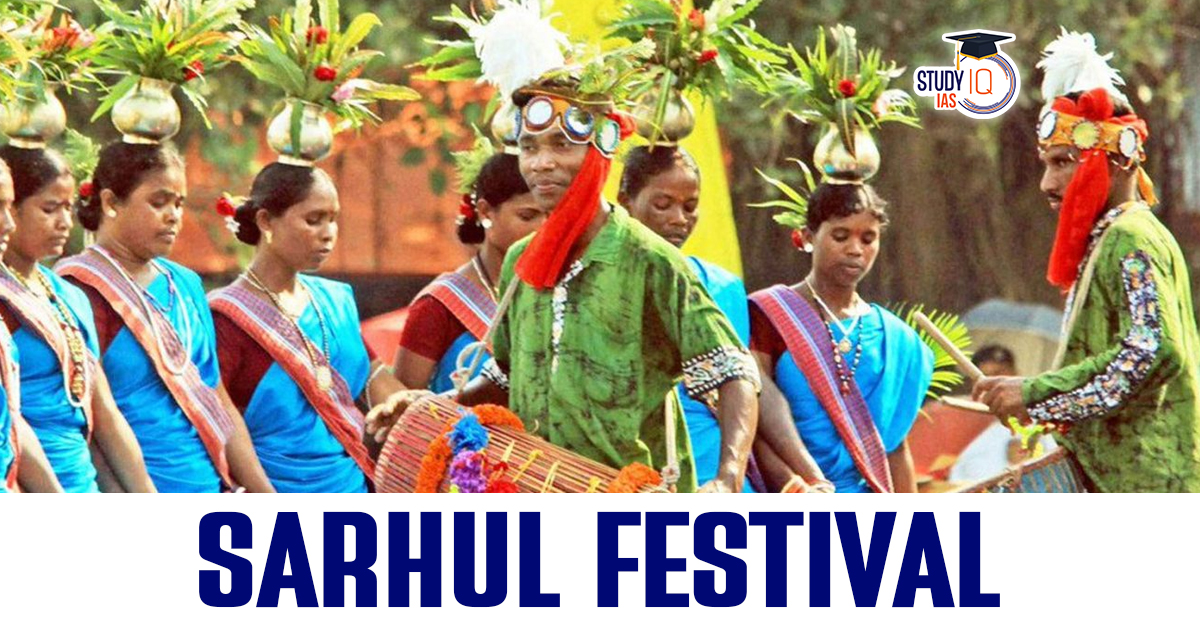Table of Contents
Sarhul is one of the most significant festivals celebrated by the Adivasi communities of Jharkhand and the larger Chhotanagpur plateau region. The term ‘Sarhul’ translates to the ‘worship of the Sal tree’, which holds immense cultural and spiritual significance for tribal communities. Marking the arrival of the new year and the spring season, Sarhul is a time of joy, gratitude, and reverence towards nature. This festival symbolizes the sacred union of the Sun and the Earth, embodying the life-giving force of nature that sustains the Adivasi way of life.
Significance of Sarhul Festival
Sarhul is more than just a celebration; it is a festival deeply rooted in Adivasi traditions, ecological consciousness, and community bonding. The festival signifies:
- The beginning of the new year for tribal communities.
- The arrival of spring, when flowers bloom and trees regenerate, representing renewal and fertility.
- An occasion to express gratitude to Mother Earth, Sal trees, and ancestral spirits for their blessings.
- A time for reconciliation and unity among community members, reinforcing social harmony.
When and Where is Sarhul Celebrated?
Sarhul is observed in the Hindu month of Chaitra (March-April), aligning with the onset of spring. The main festivities take place in Sarna Sthals, the sacred groves found in Adivasi villages. These sacred spaces serve as the center of worship and are scattered across the states of:
- Jharkhand
- Chhattisgarh
- Odisha
- Bihar
Adivasi Communities That Celebrate Sarhul
Several indigenous communities consider Sarhul as their primary festival, including:
- Oraon Tribe
- Munda Tribe
- Santal Tribe
- Khadia Tribe
- Ho Tribe
These tribes follow traditional Sarna dharma and regard nature as a divine entity.
Rituals and Traditions of Sarhul
The Sarhul festival is rich in traditional rituals that have been followed for centuries. Some of the key customs include:
1. Worship of Sal Tree (Sal Pooja)
Sarhul begins with the worship of Sal trees, considered sacred by Adivasi communities. Priests, known as Pahans, perform rituals under the Sal tree, seeking blessings for prosperity and protection.
2. Offering of Flowers and Water
Freshly bloomed Sal flowers are collected and offered to the deities and ancestors. These flowers are then distributed among villagers as a symbol of blessings and good fortune.
3. Drinking Handia (Rice Beer)
A special drink called Handia (rice beer) is prepared and consumed during Sarhul. This traditional brew is considered sacred and is shared among community members as a sign of togetherness and joy.
4. Community Feasting and Dance
Sarhul is incomplete without grand feasts featuring traditional Adivasi dishes. People sing folk songs and perform traditional dances, such as Paika and Jhumar, dressed in colorful attire, celebrating nature and life.
5. Processions and Public Celebrations
In urban areas like Ranchi, Jamshedpur, and Dumka, grand processions take place, where people march with traditional instruments like the Mandar and Nagara, dancing through the streets in vibrant attire.
Cultural and Ecological Importance of Sarhul
Sarhul embodies the deep environmental consciousness of Adivasi communities. The festival highlights:
- Forest conservation: By worshiping the Sal tree, the festival promotes awareness about protecting forests.
- Sustainable living: Adivasis rely on nature responsibly, ensuring ecological balance.
- Preservation of Indigenous Culture: Sarhul strengthens Adivasi identity and ensures that their customs and traditions are passed down through generations.
Conclusion
Sarhul is more than just a festival; it is a way of life for Adivasi communities, reinforcing their deep-rooted connection with nature, ancestors, and the divine. This vibrant celebration showcases the unique cultural heritage of Jharkhand and the surrounding regions, emphasizing unity, gratitude, and ecological consciousness. As urbanization spreads, it becomes even more crucial to recognize and preserve such indigenous traditions that hold valuable lessons about living in harmony with nature.


 Indus Water Treaty 1960 Suspended by Ind...
Indus Water Treaty 1960 Suspended by Ind...
 5 Years of SVAMITVA Scheme and Its Benef...
5 Years of SVAMITVA Scheme and Its Benef...
 Places in News for UPSC 2025 for Prelims...
Places in News for UPSC 2025 for Prelims...





















